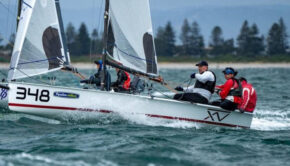Serious Frostbiting with Skip Novak
Published on November 2nd, 2016
Ullman Sails just released their new Expedition Series, which are sails engineered specifically for high-latitude sailors and explorers. The team at Ullman Sails that developed the new product includes their Brand Ambassador and sailing great Skip Novak.
Skip has been running sailing expeditions in the northern and southern high latitudes for 30 years in addition to his decorated offshore racing resume. Scuttlebutt editor Craig Leweck checks in with Skip about his style of frostbiting….
How cold are we talking?
In absolute temperature terms we do sail in sub-zero conditions, but more often at near zero or just above. If you sail in this kind of weather, and are well offshore, you stand a good chance of getting icing up on sails and rigging.
Icing can happen with a shift in the wind on the back of a cold front dropping you into minus territory. Even at above-freezing temperatures however, the wind chill makes things feel well below freezing to the touch. Very quickly you are wearing all the gear you own.
In 2014 we sailed to the Southern Ocean island of South Georgia in deep winter with two days of -5 to -7 degrees C. While broad reaching in 25 to 30 knots southwest there was an almost imperceptible mist blowing over the deck. In spite of what we thought was benign conditions at first, we could literally watch the ice form around lifelines, stanchions, shrouds, and on the deck gear.
Knocking the ice off every four hours did help, but it was a losing battle in keeping the furlers and winches free up forward. Luckily we had taken three reefs and only had a staysail flying, which was fixed in place all the way to the island. It took a day to chip and melt out all the ice once at anchor.
Although we didn’t feel threatened, if we had seen gale conditions with more water coming across the deck and more accumulation higher up the rig, stability would quickly become an issue. It was an eye opener.
Why the need for a specific series of sails for cold weather? What makes these sails different from a standard cruising sail?
Cold weather sailing usually implies windy and difficult conditions. Possibly this would be better described as ‘heavy weather sailing’, which of course can be applied to any region north or south and everything in between.
The Expedition Series meets the criteria of being able to go the distance for especially extended periods in generally a heavy weather environment without resorting to problems requiring sail loft service. This is accomplished by design and detailing parameters that are not the norm in what we call “cruising sails”. On top of that there is a safety issue at stake. In remote areas ease of sail handling and robust construction of your sails underpins this concern.
On the design side the sails feature elements that make the boat easier and safer to handle in high-wind situations. High clews, hollow leeches and less mainsail roach all contribute to this philosophy. In terms of finishing details there are a lot that make the sails safer, more durable, and easier to handle as the seas get rougher and the temperature drops. More sophisticated reefing systems, added sail controls, and upgrades that add durability against U.V. damage and the elements all come together for a complete sail package.
These sails embody innovation in engineering. Sure, they may be marginally slower in light to moderate conditions when you have a full sail plan, but for this type of sailing a conservative approach is required – you can’t have it all!
How long have you been battling sail problems in cold weather?
The first time I truly faced cold conditions was in the 1977-78 Whitbread Round the World Race. At a certain point cold weather slows things down. Clothing gets in the way, dulling your senses. Untying a simple knot or un-fouling a line with gloves or mittens becomes tedious. While you are intensely concentrating on simple tasks like that and trying to stay tacked on the deck, something else can go wrong that you would have noticed if you were unencumbered.
This situation, and really any heavy weather sailing situation, requires an adjusted mindset. You can’t rush around – things have to be thought out in order to avoid problems that are easily compounded. These Expedition Series sails help in this regard by offering solutions that minimize the opportunities for more things to go wrong. Of course the more you sail in these conditions the better you get at it. Now after 40 years of ‘self flagellation’ in cold, high-wind conditions I am quite used to it!
What is it about you and cold weather sailing?
I generally feel healthier and without doubt more energetic in the cold – and very lethargic in the deep tropics. Jimmy Buffett’s “Margaritaville” kicks in for me in hot weather. Simple as that. I suppose spending so much time in colder climates is also a consequence of my seeking out less travelled places by land and sea – and this means high latitudes and remote mountain areas. If I can combine the two all the better!
Whether it be hot or cold, rough weather sailing – and you will get some if you ‘world cruise’ – requires an upscale approach in just about every facet of fitting out a boat. Sails, and standing and running rigging definitely need to be looked at.
I would go for the next size up on every winch over the boat builder’s recommendations. Furlers ditto. Why struggle with the minimum spec? Electric winches are a bad alternative by the way – power hungry and not 100% reliable. Anchor tackle equipment and chain sizes certainly need to be upgraded to the next size up as well.
As for systems like watermakers or autopilot – you want serious pieces of equipment – not toys. These additions are really not so significant – when you add up the increased weight of all of the above, it might only mean the equivalent of one extra heavy set guest on board!










 We’ll keep your information safe.
We’ll keep your information safe.